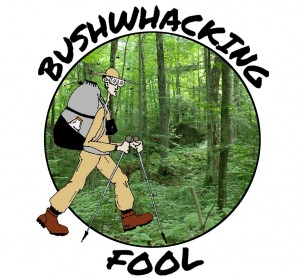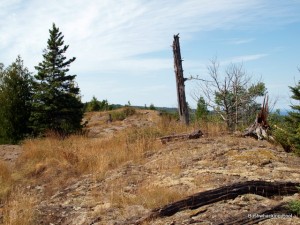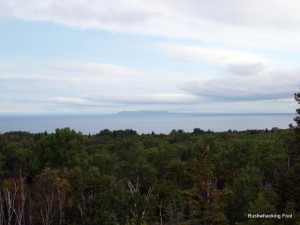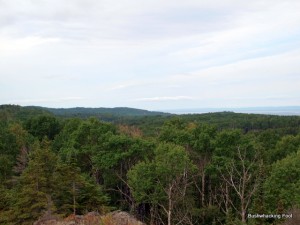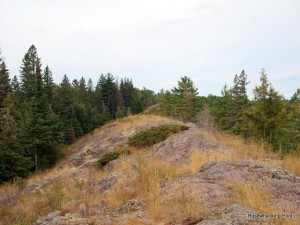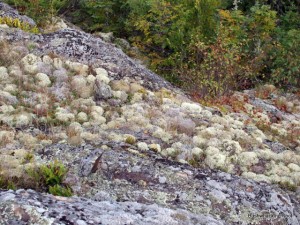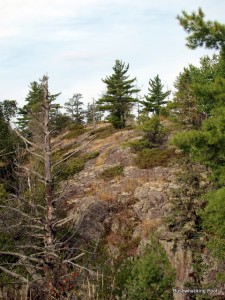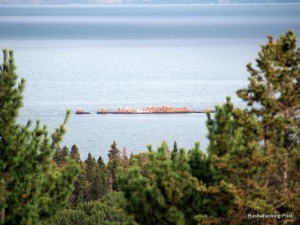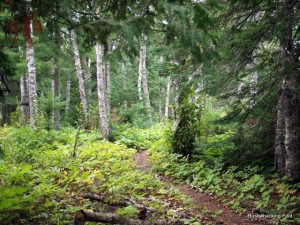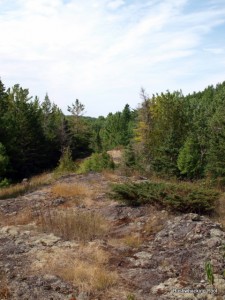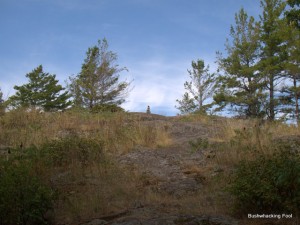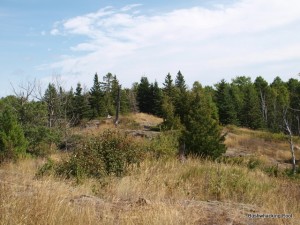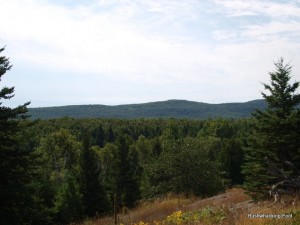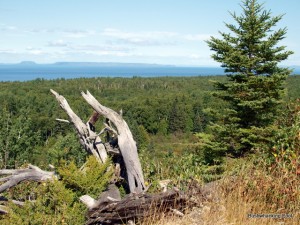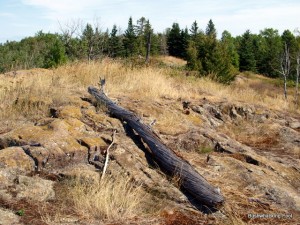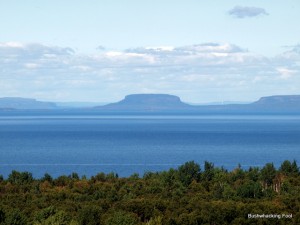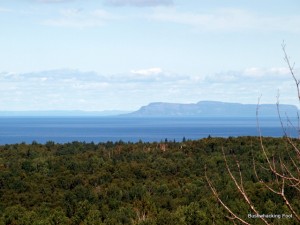The Minong Ridge leaves the Little Todd intersection and immediately cuts through a short stretch of spruce before climbing up over mostly bare rock until reaching the crest of the Minong Ridge. The ridge is a narrow rocky strip, with scattered patches of brown knee-high grass; spruces line both sides making the ridge appear somewhat tunnel-like.
Rock cairns are strategically placed along the ridge to mark the trail. These cairns are supposedly a common sign along this portion of the trail, according to the Isle Royale book by Jim DuFresne. In fact, the author maintains the cairns and some orange marking on the rock are sometimes the only way to follow the trail. For the most part, I do not find fixating on these markers necessary as the occasional patches of dry dirt and lichen-free rock are enough to keep me on track.
View Day Five, Part Two in a larger map
Section Stats:
Date: September 2, 2011
Length: 4.2 miles (4.7 total daily miles; 35.8 total trip miles)
Difficulty: Difficult (constant up and down)
Soon after leaving the intersection, a grassy, wet area appears through the trees to the south. The map shows this as open water; apparently the dry weather has taken its toll here as it has on other parts of Isle Royale I visited earlier on my trip. A quick scan for moose, and I am off again down the trail.
The trail descends off the rocky ridge and into some spruces before emerging shortly thereafter and ascending to the semi-open ridge again. Within minutes, the trail climbs once more, the ridge becoming increasingly open until I finally stand above most of the tops of the spruce trees growing lower on the ridge.
The sky is still cloudy, but luckily most of the darker clouds moved off to the east. An occasional dark cloud still hangs around, but it is mostly surrounded by more innocent-looking white clouds. A ray of sunshine breaks through the clouds now and then, but quickly disappears again.
With the recent gains in elevation, the north provides beautiful views of Lake Superior and the Canada shoreline. The views are just above the tree tops of the small stretch of island separating the ridge from the Great Lake. Wisps of clouds hover over Lake Superior, slowly giving way to blue sky. It might just turn out to be a descent day, if all this low-lying humidity blows off.
The view south is of a sea of green tree tops, over rolling terrain. The Greenstone Ridge towers over this landscape, covered in trees unlike the Minong. On this far ridge lies the trail bearing its name (or The Greenstone, in Isle Royale parlance). The Greenstone is to be my return route toward Rock Harbor during the second week of my island trip. I scan the distant ridgeline with my binoculars, looking for the Ishpeming Point fire tower, but all I see are trees, and more trees.
Before me lies the bare, rocky crest of the Minong Ridge. Although my map shows the trail maintaining a nearly straight bearing to the southwest, I can see only a small portion of it, until it vanishes within a sea of coniferous trees.
The trail soon leaves the outstanding views behind, and descends off the ridge and into a mixed forest. According to my book on the foot trails of Isle Royale, the constant up and down nature of the trail is characteristic of this section of the trail. From my experience thus far, I must concur with this opinion.
And so it goes.
The trail quickly exits the mixed forest, climbing once again onto the Minong Ridge’s rocky crest. Now the ridge’s crest is visible for a great distance, winding its way through the surrounding forest. Patches of dry, knee-high grass and dark green juniper shrubs lay interspersed within the bare rock matrix, giving the ridge an other-worldly appearance.
The spruce trees lining the ridge on both sides overtop the ridge now, making the views less impressive as earlier on the trail. Mixed with the spruce trees are eastern white pines and aspens, especially lower along the base of the rocky ridge. The tree diversity is low here, probably due to the poor condition of the rocky soils.
Unlike the surrounding forests, a great diversity of lichen grows upon the open patches of rock on the ridge. They are mostly absent in close proximity to the trail itself, worn off by a plethora of hiking boots over the years. From time to time, I notice patches of crushed lichen, where a careless hiker stepped off the trail. They should include more warnings about the fragility of these fungi/algae associations in the orientation required upon arriving to the island.
The constant up and down, in combination with the increasing amount of hazy sunlight and the high humidity, leave me drenched in sweat within my rain gear. Stopping along the trail, I shed my backpack, quickly followed by my Venture rain jacket and my Tumalo Pertex rain pants. Unfortunately, I cannot dry them on my hiking poles this time, since there is no soil to embed them in. While shedding my rain pants, a common raven flies right over my head, startling me to the point that I almost fall on my ass right on the hard, rough rocks.
Fortunately, the breeze quickly dries my sweat-dampened clothing as I continue along the semi-open Minong Ridge. More trees intrude upon the ridge, with many dead and devoid of foliage. The remaining live ones are in such low density as to not form a closed canopy and completely block the steady wind coming off Lake Superior to the northwest. The many dead trees along the trail signal the high tree mortality upon the harsh conditions along the rocky ridgeline.
Soon views to the north reappear above the tree tops. Lake Superior and a far-off Canada shoreline are welcome companions again as I continue to feel the brutal impact of the rough rock on my feet through my Garmont hiking boots.
Gull Rocks, a string of rocky islets in Lake Superior, pop into view between the trees tops. Through my binoculars, parts of the islands look covered in the white wash of gull excrement. Glimpses of Isle Royale’s shoreline back to the northeast reveals Todd Harbor, where I stayed two nights before.
After the views from the rocky ridge, the trail drops down into a paper birch forest, with an occasional scattered spruce growing along the trail. This stretch of forest does not last long, as the trail reclaims the rocky ridge, followed by views of an unnamed lake a small distance to the south.
The unnamed lake is too close, and the temptation to bushwhack to its shore is too irresistible. But that is a story for another time.
Regaining the Minong Ridge Trail after returning from the unnamed lake, the trail continues through forest, at one point over corduroy next to a large boulder. Although, this section may be muddy at other times, the mud around the cut logs is hard and dry. Leaving the corduroy, the trail slowly ascends through some red pines, and finally returns to the rocky ridge, again.
The trail continues to climb slowly along the crest of the Minong Ridge for a good distance before it finally levels off. Soon, I come upon the family of four from Little Todd taking a break from the harshness of the rocky, ridge trail. Some complaining and grumbling about the Minong ensues, but I do my best to refrain, even though my feet are plenty sore.
I distinctly remember the phrase “Minong, suck it!” being coined here.
We spend some time talking about today’s arduous section of trail. Upon request, I take a picture of them on their camera, followed by them taking a picture of me. Brad (the father) gets a cellphone signal, and posts the picture of me on their Facebook page while we stand there. Even in the wilderness, you can update your Facebook page. Is life wonderful, or what? He peruses the news, with an earthquake in Alaska being the only thing noteworthy.
Finally, we all return to the trail. I start out first, as Shelly (the mother, as well as the second person on the trail with that name) is experiencing some knee pain. Feeling really well (rejuvenated due to the short bushwhack, short break or social interaction?), I start out hiking pretty strong. The Max (the boy) keeps up with me for a while, abandoning his family for the perceived honor of hiking with a bushwhacking fool.
A steep descent into a forested ravine of sugar maple and paper birch is rapidly reached, followed by an even steeper ascent back up to the ridge once again. The steep ascent appears to be too much for the young fella, and soon he is no longer behind me. I contemplate waiting up for him, but then decide his family should be able to catch up to him soon. Plus, they will probably catch up with me when I finally stop for lunch.
The trail leads back out onto the rocky and open crest of the Minong Ridge again. According to the map, this is the highest point along the entire Minong at over 1050 feet. As I approach the top, a single cairn stands against a background of an increasingly cerulean blue sky.
The views are outstanding in every direction. The south shows the Greenstone Ridge, covered and surrounded in a sea of green trees, shadowing the Minong Ridge since it last came into view. The north shows the now familiar Lake Superior separating the island from its Canadian neighbor. The sky is partially clear now, the blue showing through some still-remaining wisps of cloud.
Not wanting to lose the view, I slow down and take my time along this part of the ridge. According to the DuFresene book, this is the best view along the Minong, especially given the few views had during tomorrow’s long slog to Windigo.
My stomach grumbles a few times and since it is nearly one in the afternoon, I decide this is a perfect place to stop for lunch. Since the last campground on the Minong is coming up at North Lake Desor, I start thinking it would be nice to let the family go ahead of me so they at least get to choose a campsite for once, instead of getting stuck with the last one. That will only happen if I linger for a while, so I plan on doing so. Where is a better place to linger than here anyway? The view is reason enough for a slow peaceful lunch break.
While I eat my tuna sandwich (complete with soy mayo, which I pray is not rancid), the family passes by as if they can smell the open barn now. Little did I know there are only three campsites at North Lake Desor. Guess who will have to double up with someone else tonight?
From my position, I can see the continuation of the Minong Ridge across a significant distance to the southwest. This should be the last big descent and subsequent climb before reaching the intersection with the North Lake Desor Campground spur trail.
As I sit and enjoy the view by myself, I can see the family move over the next rise, verifying the trail continues over the ridge after it dips down into the forest below. My National Geographic map indicates the intersection with the North Lake Desor spur trail is near, but unfortunately not as near as I would like.
After finishing lunch and taking some photographs, I return to the last stretch of the Minong Ridge Trail for the day. Following the trail into a dark paper birch forest, once again it climbs onto the last open, rocky section of the day. The trail does not stay up on the ridge for long though; it dips down right to the North Lake Desor intersection at the edge of a thick paper birch forest.
It is less humid now, with mostly clear skies, a nice breeze and cooler temperatures. Only a half of mile remains now, and North Lake Desor awaits.
Affiliate Disclaimer: Some links within this blog post may send you to a retailer website. If you chose to purchase any product at that site at that time the author will receive a small commission. These commissions provide compensation for the author’s time and effort necessary to provide the content at the Bushwhacking Fool.
